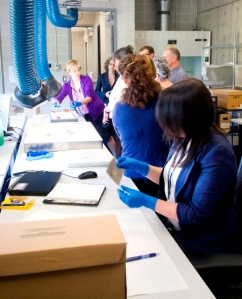In our last article we discussed the Gatineau Preservation Centre. Today, we would like to introduce to you LAC’s Nitrate Film Preservation Facility.

Exterior view of the LAC Nitrate Film Preservation Facility
Did you know that a portion of LAC’s film and photographic negative collection is nitrate-based? The collection consists of 5,575 reels of film, dating from as early as 1912, and close to 600,000 photographic negatives. Because of the potential for nitrate-based cellulose film to combust if storage temperatures are too high, LAC chose to house this material in a facility that provides a stable, cold, dry environment essential for preservation.

Light boxes displaying nitrate negatives, some of which show obvious signs of deterioration
This collection captures some of Canada’s most significant moments up until the 1950s when the medium became obsolete. Among the materials preserved at the new facility is one of Canada’s first feature films, Back to God’s Country, along with works produced by the National Film Board of Canada and photographic negatives from the collections of Yousuf Karsh.
The Nitrate Film Preservation Facility, which opened in 2011, is an eco-designed building with various sustainable features that include a “green” roof, well-insulated walls to reduce energy consumption, high-efficiency mechanical systems to reclaim energy, and technology to reduce water use.

Nitrate Film Preservation Facility work station
The state-of-the-art facility also features a range of technical innovations that meet the current standards for preservation environments and provide the required fire prevention and protection measures. The building is also equipped with 22 individual vaults, specialized monitoring and an exterior buffer zone of land for added security.
For more photographs of the Nitrate Film Preservation Facility, visit Flickr!
Questions or comments? We would love to hear from you!






